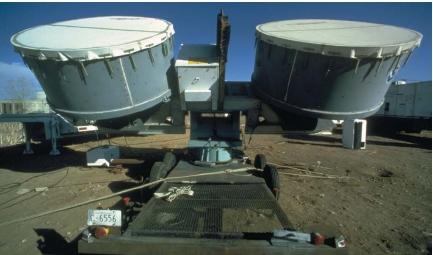Atmospheric circulation

Atmospheric circulation is the movement of air at all levels of the atmosphere over all parts of the planet. The driving force behind atmospheric circulation is solar energy, which heats the atmosphere with different intensities at the equator, the middle latitudes, and the poles. The rotation of Earth on its axis and the unequal arrangement of land and water masses on the planet also contribute to various features of atmospheric circulation.
Wind cells
There are three wind cells or circulation belts between the equator and each pole: the trade winds (Hadley cells), prevailing westerlies (Ferrell cells), and polar easterlies (polar Hadley cells). The trade winds or Hadley cells are named after the English scientist George Hadley (1685–1768), who first described them in 1753. As air is heated at the equator, it rises in the troposphere, the lowest 10 miles (16 kilometers) of Earth's atmosphere. In the wake of the warm rising air, low pressure develops at the equator. When the air reaches the top of the troposphere, called the tropopause, it can rise no farther and begins to move toward the poles, cooling in the process.
At about 30 degrees latitude north and south, the cooled air descends back to the surface, pushing the air below it toward the equator, since air flows always move toward areas of low pressure. When the north and south trade winds meet at the equator and rise again, an area of calm develops because of the lack of cross-surface winds. Early mariners called this area the doldrums (from an Old English word meaning dull) because they feared their sailing ships would be stranded by the lack of wind.
While most of the trade-wind air that sinks at 30 degrees latitude returns to the equator, some of it flows poleward. At about 60 degrees latitude north and south, this air mass meets much colder polar air (the areas where this occurs are known as polar fronts). The warmer air is forced upward by the colder air to the tropopause, where most of it moves back toward the equator, sinking at about 30 degrees latitude to continue the cycle again. These second circulation belts over the middle latitudes between 30 degrees and 60 degrees are the prevailing westerlies or Ferrell cells, named after the American meteorologist William Ferrell (1817–1891), who discovered them in 1856.
Calm regions also occur at 30 degrees latitude where Hadley cells and Ferrell cells meet because of the lack of lateral wind movement. These regions were given the name horse latitudes by sailors bringing horses to the Americas. Stranded by the lack of winds, sailors often ate their horses as supplies ran low.
The air at the top of polar fronts that does not return toward the equator moves, instead, poleward. At the poles, this air cools, sinks, and flows back to 60 degrees latitude north and south. These third circulation belts over the poles are known as polar easterlies or polar Hadley cells because they flow in the same direction as the Hadley cells near the equator. However, they are not as powerful since they lack the solar energy present at the equator.
Words to Know
Coriolis effect: Moving object appearing to travel in a curved path over the surface of a spinning body.
Doldrums: Region of the equatorial ocean where winds are light and unpredictable.
Horse latitudes: Region of the oceans around 30 degrees latitude where winds are light and unpredictable.
Jet stream: Rapidly moving band of air in the upper atmosphere.
Polar front: Relatively permanent front formed at the junction of the Ferrell and polar Hadley cells.
Trade winds: Relatively constant wind patterns that blow toward the equator at about 30 degrees latitude.
The Coriolis effect
The air flows in these three circulation belts or cells do not move in a straight north to south or south to north route. Instead, the air flows seem to move east to west or west to east. This effect was first identified by the French mathematician Gaspard-Gustave de Coriolis (1792–1843) in 1835. Coriolis observed that, because of the spinning of the planet, any moving object above Earth's surface tends to drift sideways from its course of motion. In the Northern Hemisphere, this movement is to the right of the course of motion. In the Southern Hemisphere, it is to the left. As a result, surface winds in Hadley cells—both in the equatorial and polar regions—blow from the northeast to the southwest in the Northern Hemisphere and from the southeast to the northwest in the Southern Hemisphere. Surface winds in Ferrell cells tend to blow in the opposite direction: from the southwest to the northeast in the Northern Hemisphere and from the northwest to the southeast in the Southern Hemisphere.
Variations and wind patterns
The conditions of the wind cells described above are for general models. In the real world, actual wind patterns are far more complex. Many elements play a part in disrupting these patterns from their normal course, as described by Hadley and Ferrell. Since the Sun does not always shine directly over the equator, air masses in that area are not heated equally. While some masses in a cell may be heated quickly, creating a strong flow upward, others may not receive as much solar energy, resulting in a much weaker flow. Unevenness in the surface of the planet also affects the movement of air masses in a cell. A mass moving across a uniform region, such as an ocean, may be undisturbed. Once it moves over a region with many variations, such as a mountainous area, it may become highly disturbed.

The jet streams
In 1944, an especially dramatic type of atmospheric air movement was discovered: the jet streams. These permanent air currents are located at altitudes of 30,000 to 45,000 feet (11 to 13 kilometers) and generally move with speeds ranging from about 35 to 75 miles (55 to 120 kilometers) per hour. It is not uncommon, however, for the speed of jet streams to be as high as 200 miles (320 kilometers) per hour.
These narrow tubes of air, which usually travel west to east, are created by the great temperature and pressure differences between air masses. There are four major jet streams, two in each hemisphere. Polar jet streams, formed along the polar front between the Ferrell and polar Hadley cells, move between 30 degrees and 70 degrees latitude. The other jet streams move between 20 degrees and 50 degrees latitude.
Jet streams do not move in straight lines, but in a wavelike manner. They may break apart into two separate streams and then rejoin, or not. In winter, because of greater temperature differences, jet streams are stronger and move toward the equator. In summer, with more uniform temperatures, they weaken and move poleward. The movement of the jet streams is an important factor in determining weather conditions in mid-latitude regions since they can strengthen and move low-pressure systems.
[ See also Air masses and fronts ; Global climate ; Monsoon ; Wind ]
any idea about Global Heat and Water Balance?
And thank you for some infornation about atmosphere
But i didn't understand that why winds moves in south west direction in tropics and polar area of northern hemisphere?
Please illustrate the effect of coriolis effect.